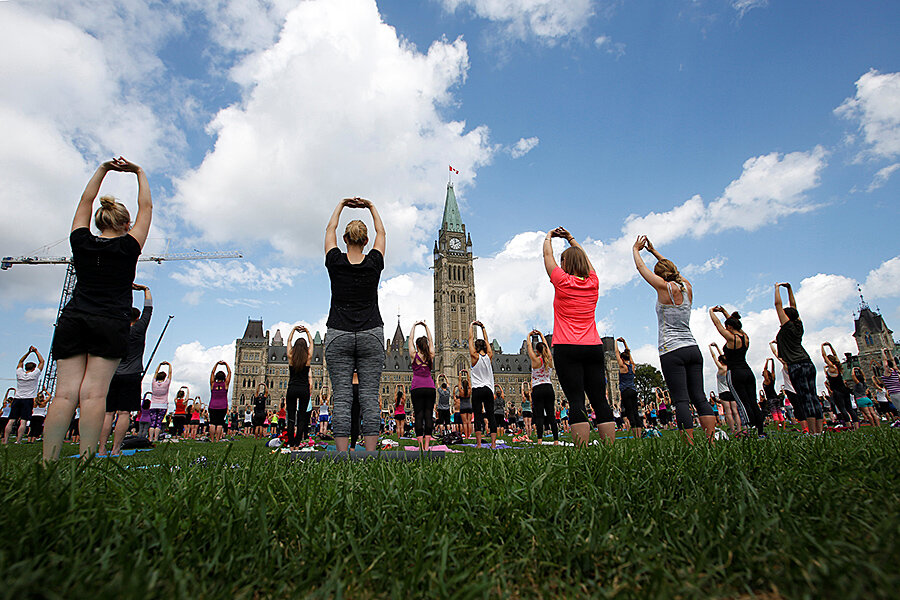Three easy ways to practice yoga on the cheap
Loading...
Yoga has a bit of a reputation. Because it’s a huge money-making industry, raking in $16 billion this year in the U.S. alone, yoga is often considered an exercise only for the elite. Many popular yoga brands advertise leggings and mats for $100 a pop, and let’s not even talk about how much you could spend on a yoga retreat — or the expensive veggie juice you seem to see every yogi clutching on her way to class.
Add that to the misconception that yoga is only for the agile and flexible (yoga is actually a method that can help you become agile and flexible), and you’re probably wondering why you even clicked on this article in the first place. What is this terribly expensive practice that’s clearly only for wealthy 12-year old gymnasts?
But I’m here to tell you that yoga is for everyone, and can be easily practiced on the cheap. Okay, I’m biased: I’m a certified yoga teacher who does yoga every day to stretch and strengthen. Yoga helps me manage my aches and pains, and it elevates my mood too. Studies have suggested that gentle yoga helps reduce lower-back pain, and can aid in relieving anxiety and depression.
Since most yoga classes— even those in smaller cities — can cost $15-20 an hour, I practice at home, in a little corner in my studio apartment. I spend $18 per month to practice yoga, using a streaming video service called YogaGlo. But you, my friend, can do it for even less. Here’s how:
Load up on cheap mats, props and workout gear.
First off, you'll need a yoga mat so you can get good traction and a little bit of cushioning when you’re down on the floor. As a person who owns both a $100 Manduka mat and the most basic, classic $20 yoga mat in the world, I much prefer the $20 mat. Don’t get caught up in the yoga hype: expensive is not always better.
Yoga props like blankets, blocks, and straps are wonderful to have when you’re starting out. They provide cushioning, prevent injury, and bring the floor closer to you, which is great if your toes seem to languish 1,000 miles away from your fingertips when you’re in a forward fold. The good news is, you don’t need to invest in these props. Have a towel or scarf? That’s a strap. Have a couch cushion and some hardcover books? Those are great substitutes for blocks. Have a blanket? Any blanket is a yoga blanket.
Now that you have the basic equipment, all you need to do is put on a pair of $100 spandex pants and you’re ready to start your home practice. Wait, just kidding! If you’re at home, you can do yoga in your underwear. You have my permission. And if you do venture out to a class, any old workout clothes will do just fine. If you’re just dying to be trendy, Nordstrom often has fun yoga leggings on sale. If you want to look runway ready before every workout, check out fashion editor Lindsay's recent article on swapping high-end workout gear for cheaper dupes.
Want to practice at home? There are tons of great (and free!) yoga videos online.
Now that you’ve got your props, you’re ready to start your practice. It’s time to make friends with YouTube! There are lots of YouTube channels devoted to yoga. Yoga with Adriene is a popular channel that features everything from slow beginner’s yoga, to yoga for anxiety, and even yoga for different injuries and conditions. If you’re a seasoned practitioner and want to try more advanced poses, check out KinoYoga.
There are thousands of teachers who upload free classes to YouTube, so it’s all about knowing what to search. If you want a sweatier practice, search for "vinyasa yoga." For more stretching and relaxation, search for "hatha yoga." And don’t forget to use the word "beginner" in your searches if you are just starting out!
My favorite online yoga resource is YogaGlo. This is a paid service that features over 3,900 classes and 34 internationally-known yoga teachers, all of whom specialize in different types of yoga. It’s a great place to take classes if you’re interested in yoga philosophy or the more spiritual aspects of yoga. It also labels classes by level, so you can take classes based on your yoga expertise. YogaGlo offers a free trial, and, at the time of publication, costs $18 a month.
There are lots of low-budget options for in-person yoga classes, too.
Ready to venture out to a class? Many yoga studios offer one free community class each week. Take some time and search for local studios online, or use your old-fashioned rotary phone to call around.
Many studios offer work-exchange programs as well. This means you work a couple of hours per week (possibly working the desk, maintaining the website, or cleaning) in order to take free classes in-studio. This is a great way to keep your practice affordable and meet more yogis. Reach out to studios for these opportunities via phone or email. Make sure to mention what attracted you to the studio and why you love yoga!
A home yoga practice can be rewarding and balancing, and doesn’t have to be expensive. Start slow and you’ll be on your way to touching those toes in no time.
This story originally appeared on Brad's Deals.







